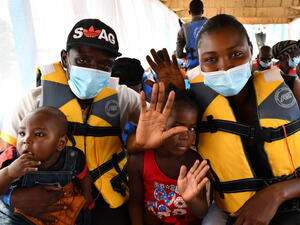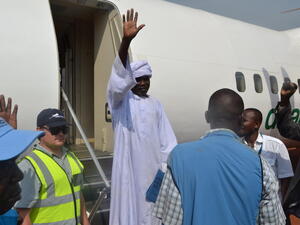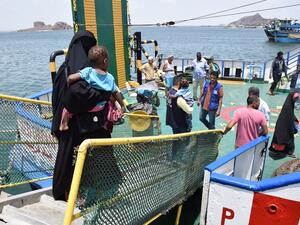Voluntary repatriation of Angolans accelerates as new corridor opens up in the north
Voluntary repatriation of Angolans accelerates as new corridor opens up in the north
The returnee delegation received a hugely emotional welcome almost everywhere they went in their home town of Tambura.
LUANDA, October 19 (UNHCR) - A convoy carrying 211 returning refugees arrived in Angola on Wednesday along a newly de-mined road from the Democratic Republic of the Congo (DRC), marking a new milestone in the UN refugee agency's voluntary repatriation programme for Angolans who fled that country's 27 years of civil war.
The road connecting Kimvula in the DRC's Bas Congo province to Sakandica in Angola's Uíge province is the last new corridor planned this year by UNHCR for the repatriation programme, which is now in its final stages. Since 2002, more than 333,000 refugees have returned to Angola, nearly 200,000 of them with assistance from UNHCR.
"Now that the war is over, and - most importantly - that elections are expected in 2006, repatriation is another symbol of the conclusion of the war and of a new era of peace," said Annette Nyekan, UNHCR's deputy representative in Angola.
This latest corridor is a typical example of the difficulties that have confronted refugees and UNHCR during the repatriation to Angola, which was devastated by nearly three decades of civil war. Everywhere, bridges had to be rebuilt and roads cleared of mines. After each rainy season, routes have to be checked again because the mines shift in the muddy soil.
Nearly 6,500 Angolans who had taken refuge in DRC are expected to use the new route into the north-west of Angola before the onset of heavy rains in a couple of months disrupts repatriation in this area. UNHCR staff will escort two convoys, each carrying around 400 returnees, every week.
It is not just the road to Sakandica from DRC that has had to be de-mined, but a total of over 300 km of roads inside Angola. The de-mining has been crucial not only because it was necessary to permit the transport of refugees to their home areas, but also because it was essential for the movement of supplies for the UNHCR operation.
The three-year repatriation programme to Angola has involved returns from all of the neighbouring countries, and even beyond. But the largest numbers have come from the DRC and Zambia.
The opening of additional access to DRC - another corridor, this time to Angola's Lunda Norte province, carried its first convoy earlier this month - has helped raise repatriation from DRC to more than 5,000 so far this year. Since the UNHCR programme began in 2003, 45,600 Angolan refugees have returned from DRC. An additional 22,000 Angolan refugees returned on their own from there.
Nearly 86,000 Angolan refugees have returned from Zambia since 2003, 58,000 with UNHCR assistance and the rest on their own. This year alone, more than 10,000 have been taken home by UNHCR in an airlift using chartered planes and 3,000 have travelled home by road.
From the south, more than 230 Angolans have returned from Namibia this year, 98 in an airlift and the rest by road so they could take their cattle back with them. That brings the total returning from Namibia since 2003 to almost 9,000 with UNHCR assistance and 3,200 on their own.
Except for some Angolan refugees returning from South Africa and the Republic of Congo, UNHCR's organized repatriation is scheduled to end this year as the number of Angolans still outside the country who are planning to return dwindles. However, the programme could be extended for operational reasons into the first quarter of 2006. The UN refugee agency says it will continue to monitor the situation in case the repatriation situation changes.
Refugees returning by themselves after the end of organized repatriation in 2006 will continue to receive the assistance provided on arrival at UNHCR reception centres in Angola. These food and non-food items range from cooking equipment and pails to more specialized kits containing tools to build houses and other kits with seeds and tools to resume agriculture.
UNHCR will focus in 2006 on supporting the re-integration of the returnees into their home areas, which are concentrated in the most isolated and heavily damaged parts of Angola.
Earlier this year, the government of Angola launched the Sustainable Reintegration Initiative for areas where refugees have been returning, as part of its national development plans. UNHCR has supported this initiative, and will try to ensure that development agencies include the returnee areas into their planning. The agency will also help fund key re-integration projects.








